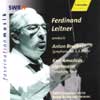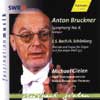Bruckner Symphony No 6
The best of the Bruckner is Gielen's Sixth, but the real gem is Leitner's Hartmann Six
View record and artist detailsRecord and Artist Details
Composer or Director: Anton Bruckner, Karl Amadeus Hartmann
Genre:
Orchestral
Label: Faszination Musik
Magazine Review Date: 11/2002
Media Format: CD or Download
Media Runtime: 80
Mastering:
ADD
Catalogue Number: 93 051

Tracks:
| Composition | Artist Credit |
|---|---|
| Symphony No. 6 |
Anton Bruckner, Composer
Anton Bruckner, Composer Ferdinand Leitner, Conductor South West German Radio Symphony Orchestra, Baden-Baden and Freiburg |
Composer or Director: Anton Bruckner
Genre:
Orchestral
Label: Hänssler
Magazine Review Date: 11/2002
Media Format: CD or Download
Media Runtime: 0
Mastering:
Stereo
DDD
Catalogue Number: 93 052

Tracks:
| Composition | Artist Credit |
|---|---|
| Symphony No. 9 |
Anton Bruckner, Composer
Anton Bruckner, Composer Ferdinand Leitner, Conductor Stuttgart Radio Symphony Orchestra |
Composer or Director: Anton Bruckner, Johann Sebastian Bach
Genre:
Orchestral
Label: Faszination Musik
Magazine Review Date: 11/2002
Media Format: CD or Download
Media Runtime: 72
Mastering:
Stereo
DDD
Catalogue Number: 93 058

Tracks:
| Composition | Artist Credit |
|---|---|
| Symphony No. 6 |
Anton Bruckner, Composer
Anton Bruckner, Composer Michael Gielen, Conductor South West German Radio Symphony Orchestra, Baden-Baden and Freiburg |
| Preludes and Fugues, Movement: Prelude and Fugue in E flat, BWV552 (from Clavier-I) |
Johann Sebastian Bach, Composer
Johann Sebastian Bach, Composer Michael Gielen, Conductor South West German Radio Symphony Orchestra, Baden-Baden and Freiburg |
Author: Richard Osborne
That's the good news. The news from the Bruckner front is rather less exciting despite the fact that this latest account of the elusive Sixth Symphony is pretty well spot-on as a reading. As in his inspired account of the Third Symphony (9/02), Gielen sculpts and paces the music with intelligence and flair. What is likely to make the performance less desirable on repeated hearings is the orchestral playing. Like Sibelius's Third, Bruckner's Sixth is an awkward little number which needs to sound as clear as day but which most orchestras get to play once in a blue moon. Not the least of the virtues of Klemperer's wonderfully durable 1965 account is the New Philharmonia Orchestra's precise and resolute playing. Gielen's fill-up is fun, a searing account of Schoenberg's arrangement - ruthless big-band 'clarification' might be a better description - of Bach's Prelude and Fugue in E flat, St Anne.
Leitner's Bruckner has grand moments but some less-than-convincing times in between. He is good on headlines, less good on argument and fine detail. Even in the 1950s when Deutsche Grammophon used him as a house conductor - EMI and Decca having snaffled up all the 'great' German conductors in the post-war settlement - he was rarely entrusted with mainstream symphonic repertoire and, when he was, his readings were workmanlike rather than inspired. Little had changed by the 1980s, if these Hänssler Bruckner performances are anything to go by.The Hartmann is another matter. The Sixth Symphony, premièred by Jochum in 1953 and recorded by Fricsay in 1955 (DG 7/58, nla), is in two movements: an at times apocalyptic but ultimately serene slow opening movement and a searing Toccata variata in which two of the three fugue subjects are variants of the first. If there are influences to be found, they are Berg in the first movement, Bartók in the second. Reviewing the not entirely successful Botstein recording, Guy Rickards referred to this as 'white-knuckle-ride' music. And so it is, though the ride itself has you looking at the stars.
Current front-runners are Kubelík's 1981 Wergo recording - part of a four-disc set of the Hartmann symphonies in which Leitner conducts Symphony No 3 - and the Metzmacher on EMI. Leitner's performance eclipses both, not least because the recording, made in the Hans Rosbaud-Studio of South-West German Radio in 1982, is itself a tour de force. Where Metzmacher and his engineers allow the large percussion section to bellow and bludgeon its way through the Toccata, Leitner and his SWR engineers place timpani, piano and xylophone with pin-point accuracy, further ensuring that the music's explosive force is generated from within, not imposed from without.
Discover the world's largest classical music catalogue with Presto Music.

Gramophone Digital Club
- Digital Edition
- Digital Archive
- Reviews Database
- Full website access
From £8.75 / month
Subscribe
Gramophone Full Club
- Print Edition
- Digital Edition
- Digital Archive
- Reviews Database
- Full website access
From £11.00 / month
Subscribe
If you are a library, university or other organisation that would be interested in an institutional subscription to Gramophone please click here for further information.




